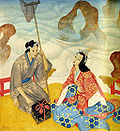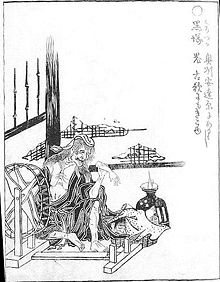- Onibaba (folklore)
-
This article is about the mythical creature. For the media franchise of similar name, see Kurozuka.
Onibaba (鬼婆 lit. demon hag) is an Oni from Japanese folklore that has the appearance of an old woman but is a yōkai that feasts on humans. Variously known as the “Demon-Hag,” “Old Hag,” “Mountain Woman,” “the Goblin of Adachigahara,” and “Kurozuka,” the Onibaba has many stories behind her name.[1]
Contents
Characteristics
The Onibaba has the appearance of a shriveled old woman. Some of her more distinctive features include having a disheveled, maniacal appearance, wild-looking hair, and an oversized mouth.[2] She is sometimes depicted with a kitchen knife or sitting with a spool of thread.[3][4] She often conceals her demonic appearance in order to put visitors into a false sense of security.
The woman from whom the Onibaba originated is said to have lived in a cave or small house in Adachi-ga-hara (安達が原 lit. the moor of Adachi) and died close-by, in a place called Kurozuka ( 黒塚).[5] There is a small museum in Adachigahara that is said to hold her remains as well as the cooking pot and knife that she used on her victims.[6]
Portrayal
Tale of Origin
One version of the story of the creation of the Onibaba involves the baby girl of a wealthy family in Kyoto. Although already five-years-old and otherwise healthy and happy, the child had not uttered a sound since birth. Worried and desperate, the family consulted doctor after doctor with no success until they came upon a fortune teller who told them that the cure was to feed the girl the fresh liver of a living fetus. This gruesome task was passed on to her nanny who set off on the search after leaving her own similarly aged daughter an omamori, an amulet for protection. The nanny’s search for a woman willing to give up her unborn child’s liver lasted for weeks and months before the nanny, tired and weary, reached Adachigahara, where she decided to stay in a cave to wait for pregnant travelers to pass by. Years passed before a lone pregnant woman approached her cave. Desperate, the nanny jumped upon the woman and retrieved the fetus’ liver. Only after accomplishing her goal did she realize that the woman was wearing the omamori she had given her daughter many years ago. Driven insane by this realization, the nanny became a yōkai and from then on attacked passers-by and ate their flesh.[7]
In another version of the story, the nanny goes on the trip because she loves the child she is nursing. In this version, the nanny has no daughter - the cure is a pregnant woman’s liver instead of the fetus’ liver.[8]
The Noh Play Kurozuka
There is a Noh play by the name of Kurozuka that tells the story of two priests who stop by the hut of the Onibaba in Adachi. The Onibaba, in her human form, kindly lets them in and speaks to them about her loneliness while spinning thread. Later, she leaves to gather firewood, but tells the priests not to look into the inner room of the house. Curious, the servant disobeys and the priests find that the inner room is filled with the bones and rotting corpses of people. They realize that the woman is the goblin of Adachi. As they are about to run away, the Onibaba returned, outraged, and in her demon form. They were able to escape through the power of their Buddhist prayers.[9]
Onibaba the Movie
In 1964, Scriptwriter and Director Kaneto Shindō made the film Onibaba based upon an old Buddhist fable by the name of "A Mask with Flesh Scared a Wife." [10] The fable tells the tale of a woman who, jealous of her virtuous daughter-in-law, dons a mask and tries to scare the girl and stop her from meeting her lover. The woman fails because the daughter-in-law’s love is much stronger than her fear of the supposed-demon. As punishment from Buddha, the mask permanently bonds to her face.[11]
The Transformation of the Onibaba
In stark contrast to the original portrayals of the Onibaba, the Onibaba has undergone a few striking transformations. One example is that of Bappy-chan[12], the Onibaba mascot of the Adachigahara Furusatomura Village, a tourist destination in Japan depicting a replica of a traditional Japanese village that lies on the Onibaba’s stomping grounds. Unsurprisingly, Bappy-chan has horns and fangs, sports an angry face, and is posed in a fashion as if she were about to chase after you. But controversially according to her original image, she is drawn in a super-deformed fashion that gives her a harmless, cute, and loveable appearance. The Village sells merchandise featuring Bappy-chan and even offers a virtual Onibaba for download on their website.[13]
Another example of the transformation of Onibaba is the anime and manga Kurozuka[14]. In this series the Noh story of the Onibaba is portraiyed, with the Onibaba masquerading as a beautiful woman with a slender body and long dark hair and with powers similar to a vampire. The difference between the Noh story and the series is that instead of the two priests escaping, one of the men, a feudal lord, falls in love with the Onibaba in her beautiful form and is transformed into a vampire by the Onibaba and her vampiristic powers.
Common Usage of “Onibaba”
In Japan, the word Onibaba does not always refer to the Onibaba of folklore. The word Onibaba, literally translated as demon/ogre/devil-hag, may also refer to witch, penurious or spiteful old woman, termagant, or virago.[15]
External links
References
- ^ Matt Alt and Hiroko Yoda, Yokai Attack! The Japanese Monster Survival Guide (Tokyo: Kodansha International, 2008), 74.
- ^ Ibid.
- ^ “02Adachigahara” <https://eee.uci.edu/clients/sbklein/images/NOH/adachigahara/pages/02Adachigahara.htm> (accessed 19 April 2009).
- ^ “05kurozuka” <https://eee.uci.edu/clients/sbklein/images/NOH/adachigahara/pages/05kurozuka.htm> (accessed 19 April 2009).
- ^ “二本松歳時記”<http://bappychan.com/saijiki/saijiki.html> (accessed 19 April 2009).
- ^ Alt, 76
- ^ Ibid.
- ^ “黒塚劇場”<http://bappychan.com/kurozuka/kurozuka.html> (accessed 19 April 2009).
- ^ “Theatre Nohgaku [ Projects ] Kurozuka” (2004). Available from: Theater Nohgaku <http://www.theatrenohgaku.org/projects/2004_e.php> (accessed 19 April 2009).
- ^ “Onibaba” (2005). Available from: DVD Times <http://www.dvdtimes.co.uk/content.php?contentid=58304> (accessed 19 April 2009).
- ^ Ibid.
- ^ http://bappychan.com/nurie/nurie2.html
- ^ Alt, 77.
- ^ http://news.dengeki.com/elem/000/000/107/107561/
- ^ http://jisho.org/words?jap=onibaba&eng=&dict=edict
Japanese folklore 
Folktales 
Text collections Legendary creatures Mythology in popular culture · Legendary creatures Categories:- Japanese legendary creatures
- Japanese folklore
Wikimedia Foundation. 2010.


